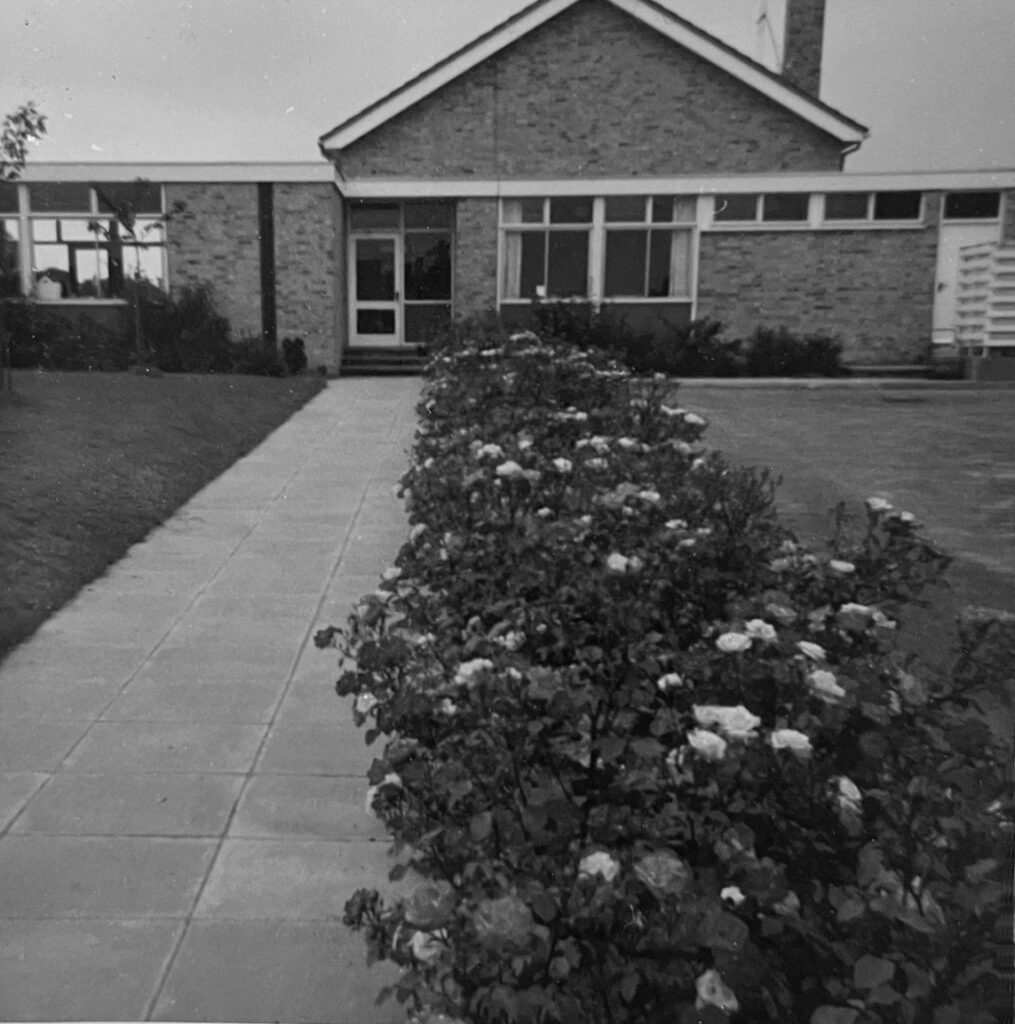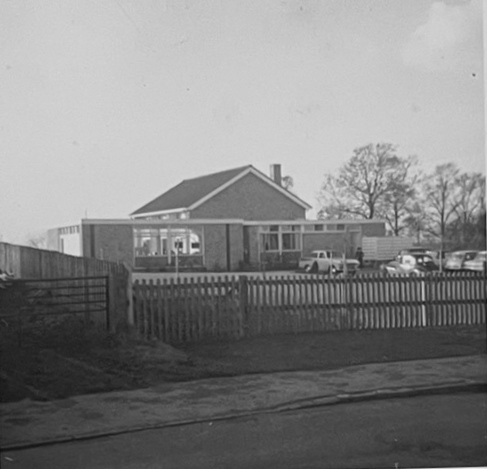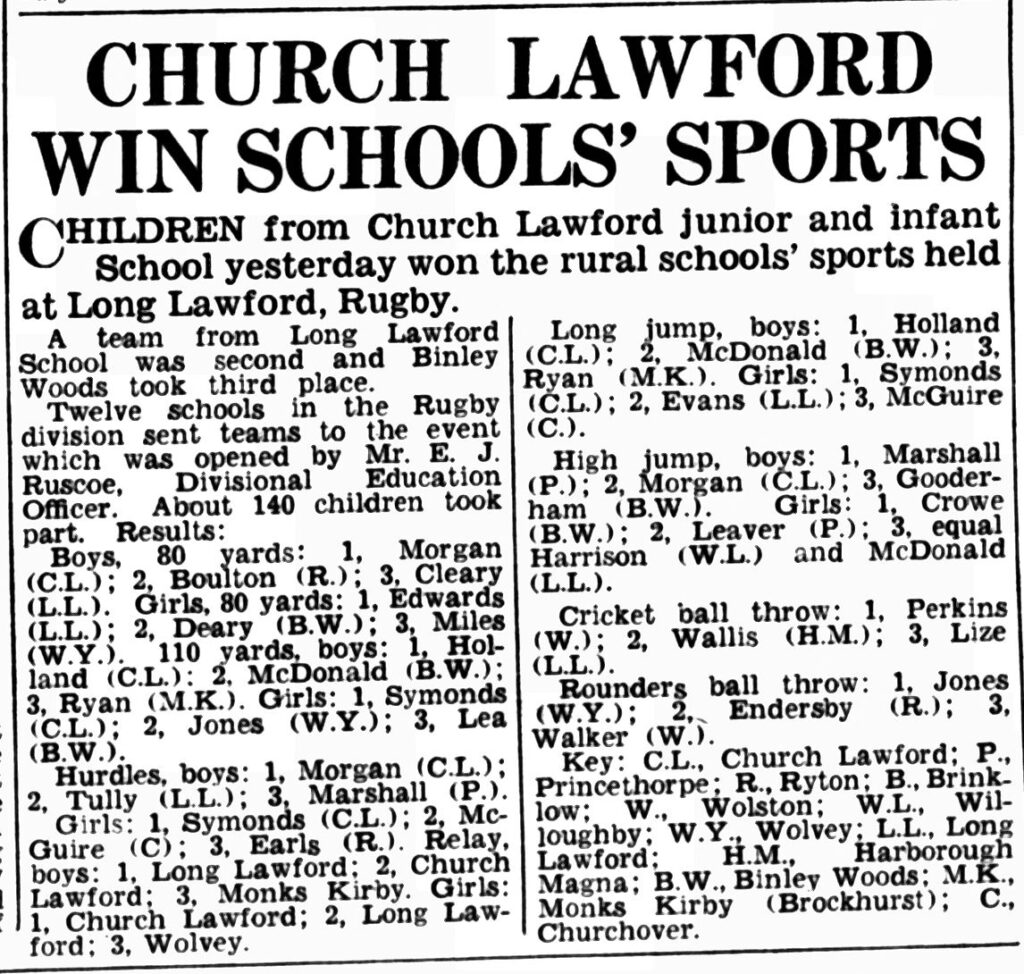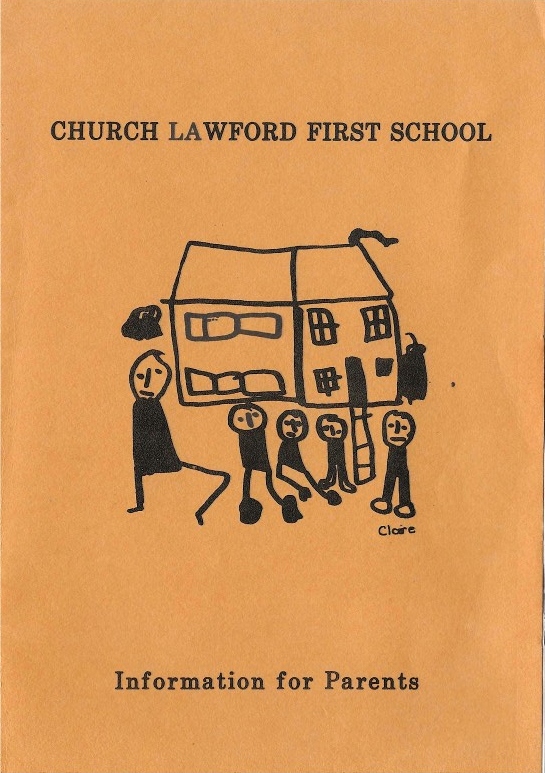On 6th February 1964 the newly built village school opened its doors to children for the first time.
The new school was also on School Street, just a hundred yards or so further down the street, opposite the Village Green, in an area formerly part of Fir Tree farm, and it also was next to the village Reading Room and War Memorial. It was a junior and infants school, originally operating with three classes, and quickly built up a good reputation, such that some children from Bretford, Wolston and Long Lawford also attended the school for their entire primary education. The infants class taught children in their first three years of schooling. Class 2 was for the next two years, and then Class 1 was for two further years leading up to the “Eleven-Plus” exam. Children would then move into secondary education, either at one of the schools in Rugby, or Wolston High School.

The first school head was Winifred Baker, who had been headmistress at the old school for 10 years up until then. As the school opened in the middle of a school year the group of children doing their eleven-plus that year continued in the old school. By the start of the Easter Term in 1964 there were 77 on the school roll. Miss Baker had to deal with multiple teething issues with the new building, notably with the oil-powered heating, and also a number of break-ins, particularly in the school holidays. Those helping from the village were Mrs Ingram – the school cook, Mrs Heckford (snr) the school helper, Mrs Farmer (snr) the Caretaker (Mrs Cresswell joined her shortly afterwards) and Mrs McCrow the dinner assistant. Mrs Hagan began as the “traffic warden” shortly afterwards, helping the children across the main road in the days before the reduced speed limit.
Events at the school would include the visits each term of the school nurse, football and netball matches and athletic events against nearby schools, weekly swimming classes at Rugby baths in Regent Street, school trips such as the visit to Dudley Zoo in the early years, visits from various guests on topics such as road safety (Coco the clown followed by the Tufty Club). Music competitions, school choir events and rural sports days were held in conjunction with other local schools, as well as them staging the cycling proficiency test. Mrs Wotherspoon and Mrs Faizey were the school managers, both having had teaching experience (Mrs Wotherspoon had been headmistress at the old school in the past, and Mrs Faizey helped out with the teaching at the new school).

This “New School” had plenty of advantages over the “old” school. There were 3 separate classrooms, not needing any partitions seen in the old school. There were indoor toilets – especially important in the winter! There was a separate assembly hall, with PE equipment. There was a sports field – maintained by the council – even with a permanent long jump pit, and (mostly) there was better heating. Within a short while the old wooden radio used to play the school programmes from the BBC was supplemented by a TV on a trolley – although the reception was rather intermittent. School Sports days could then be added to the calendar – the three-legged race proved especially popular.
Within a year of the school opening there were already reports and rumours that the school might close. In 1965 the threat came from a possible merger with Wolston School, with Brandon School also being incorporated into a rebuilt school in Wolston – this proved to be the first of a succession of threats to the modern village school.
The improved facilities in the new school included the sports field with a football pitch, two running tracks (straight and circular), long jump and high jump pits with the sports equipment to match. Within a couple of years this began to pay dividends as seen in the report from the Coventry Evening Telegraph of June 1966.

Miss Baker moved on to become head of Bawnmore Junior School in Rugby at Easter in 1966, and was followed by Bryan Greves for the Summer Term that year. There were 80 on the school roll when Mr Greves took over. After three years he left and Hilda Martin took over for the next eleven years, with 63 children on the school roll when she took over.
In these days the school was also used for Parish Council meetings, as well as for voting in the local and general elections.
Shortly after the school was opened there was a dedication service for the Church of England school. This was reported in the March 1964 newsletter thus:
On. Tuesday, February 18th about 90 Parents and friends attended the Dedication Service of our Church Lawford C. of E. Primary and Junior School.
The Rev. G.R. Fishley (Diocesan Director of Religious Education) dedicated the School, the Rector assisting at the Service.
David Wilkins, head of school read St Luke II verses 41-52 and Susan Smallman read Philippians IV v 4-8.
The hymns were Thy Hand, O God, has guided, Teach me my God and King” and “Praise my Soul the King of Heaven”.
Mr. E.J. Ruscoe, Divisional Education Officer, Mr. & Mrs. Morgan (Chairman of Parish Council) The School Managers and Miss Townsend attended. Miss Townsend, who was the first to be baptised (1873) in our present church, remarked on the good behaviour, excellent reading and singing of the children. Miss W. Baker, Head Teacher, and her staff are to be congratulated on having such a spacious and up to date School.
The new school originally functioned as both infant and junior school, taking children aged 5 to 11 years. After only four years the Education Committee started to consider redesignating the school as a ‘First School’ and although the efforts of an action committee managed to delay this change for three years. Various press articles of that time reflect how involved the village became trying to save their school from being partitioned – with many realising what this might lead to. Reverend Dennis Spiller even wrote to Margaret Thatcher, then the Education Minister, telling her only two out of 70 parents in the village supported the idea of bussing their children to a middle school in Long Lawford. A meeting of the Education Committee in the spring of 1971 was warned with what proved to be very prophetic words – as recorded in the Rugby Advertiser thus:
Mrs. Elizabeth Howells, a parent, said: “We have been accused of being reactionary but it is dangerous to take away children from their own village when they are so young. “If this goes through we shall end up as a dormitory place where only people who haven’t got children of school age will want to live.”
Parish Councillor Roger Lane said: “Church Lawford is growing and more couples are moving into the village because they can see the school as the hub of village life. Let there be no doubt that if this school caters only for five to eight year olds young couples will not move into the village. “Future development will be stifled and the school will fall victim to those who would have it closed. Who can imagine an authority running a school with a handful of infants?”.
However, by early 1972, with the full support of Long Lawford Parish Council, the change had been approved, and was first enacted towards the end of 1972-73 school year with a phased approach exposing various problems with transport arrangements (up to 9 children having to share a car provided when a mini-bus was unavailable), but the full transition went ahead the following school year. Pupils’ ages in the revised Church Lawford First School then ranged from 5 to 8 years, with those above the age of 8 having to be educated at the expanded Long Lawford Middle School. This redesignation thus reduced pupil intake by approximately 40% and heralded the predicted decline in the school’s fortunes. More on the Long Lawford Middle School, via a Rugby Advertiser feature in 1975, can be found here.
In 1981 Maureen Allison took over as School Head, and one of the Parents’ Guides from her tenure can be found at this link.
After a short period of stability in this revised state, the local authority then started to consider closing the school – something widely predicted when the first change was made. The first threat of closure came during the 1988-89 school year, and moved nearer at the start of 1990 as discussed here, but was withdrawn in May of that year following vehement local apposition.
The final proposal to close the school was part of a county-wide Education Reform / Cost Saving, with an announcement in 1993, following by campaigning in 1994, with an application for Grant Maintained status at the end of the year, but after an anxious wait during the first part of 1995, closure was confirmed.
The school closed in 1996, with an exhibition and Thanksgiving Service. The Valedictory Address summarised the history of the Village School.
Perhaps some of the words from that address sum things up admirably:
<the school> is now closing thanks to the efforts of the Local Education Authority.
That is a cause for great sadness, but we are here today to give thanks for our school and to celebrate its successes and contribution to the life of the community. Over 150 years hundreds, possibly thousands, of children have passed through the school and received a sound education, not just in the 3 Rs but in the social and moral standards which shape their lives and that of our community. The most recent are here today but so are many others as parents and grandparents.
A school is not just a building it is also the pupils, staff, and governors. It is the volunteers who help in the school, who raise funds, and who give of their time unstintingly. It is the community which supports the school and the school in the heart of the community.

More on the various campaigns to save the Village School is held in the research section of this archive.

The closure and subsequent demolition of the old school in the early 1970s gave birth to ‘The School Houses Charity’. This charity, established in 1980, disburses the income from a portion of the proceeds from the sale of land on which the old school once stood. Under the terms of the charity, those residing in our two parishes may apply for modest grants to further religious or general education.
The buildings remained empty for a number of years after closure. During this time a small band of people from both villages formed an action group to investigate options for making good the community benefits lost by closing the village school. Purchase and renovation of the buildings was considered, but deemed too expensive. Finally, a plan to renovate/ redevelop the old Reading Room was adopted but this was later abandoned in favour of complete demolition and wholesale replacement by a new village hall. The school buildings, too, were demolished and the site sold for private housing, giving rise to the Townsend Close development (the name of which was chosen to maintain a connection with the Townsend family, benefactors of the Reading Room), Meanwhile, the action group persuaded the County Council to allow the parish council to purchase the former school sports field for use by the community for general recreational purposes.
